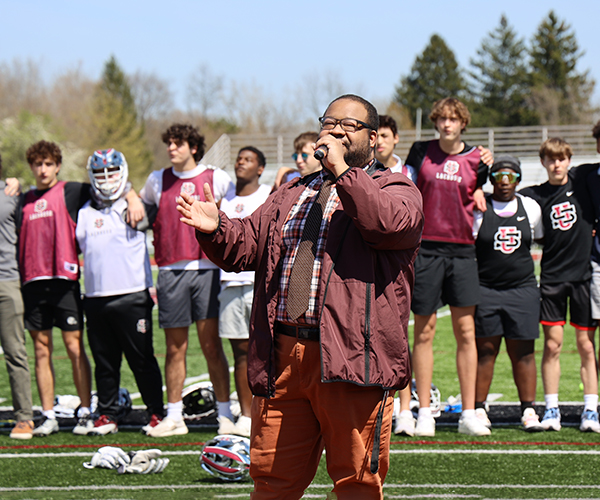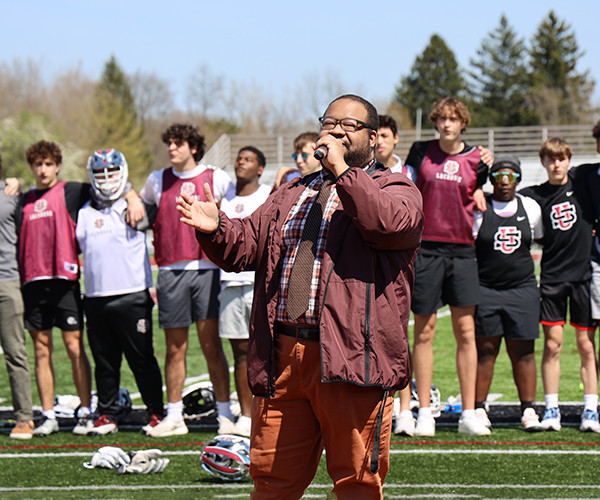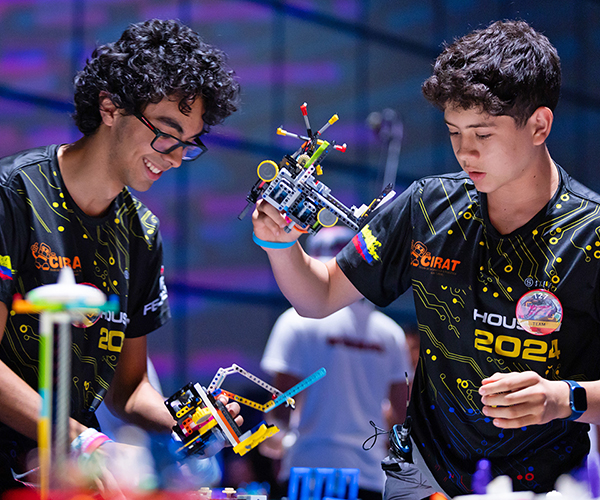Teresa Jenkins wanted her Lake Ridge Academy debate class to tackle a current issue that connected with their lives. So she split the eight high school juniors and seniors into two sides to consider a national high school ban on contact sports such as football associated with concussions and other serious injuries.
Over the next week and a half, each group gathered sources, pored over academic research and read popular sports articles from ESPN and Bleacher Report to build their arguments. The students even shared their findings with the opposition, who could evaluate the sources’ timeliness, context and potential biases.
“You need to make sure your source is credible,” says Jenkins. “Because it makes you more persuasive and trustworthy.”
During the debate, however, one student who opposed the ban downplayed the risks by using injury data that included both middle school and high school athletes as well as participants in contact and noncontact sports. The broad sample skewed the percentage of serious injuries to favor his argument, and his classmates called him out.
“They realized that they have to be careful about these types of statistics,” says Jenkins, “because people can be manipulating them.”
More schools are emphasizing how to research, analyze and evaluate information as part of a skill set often known as digital literacy, which includes critical thinking, creativity and collaboration; online safety and behavior; and the ability to engage with various and complex viewpoints.
Gone are the days when everyone reads the same daily newspaper and watches one of three TV news programs at 6 or 11 p.m. Last year, North Americans consumed an average of 601.5 minutes of media per day, according to research firm Zenith. Largely driven by the increase in mobile internet usage, which accounted for 19 percent of all media consumption globally, that’s the highest level Zenith has tracked.
This is especially true for middle and high school students, who have grown up with smartphones in their hands. There is little separation between their digital and real worlds. They’re bombarded daily by videos, text messages, news stories, memes, snaps and more, making the ability to access, analyze, evaluate and create media a vital skill for their educational and future success.
“We’re living in an era where kids are so immersed in media culture,” says Terry Dubow, a journalism and media literacy teacher at Hawken School in Gates Mills. “If schools don’t help students understand these forces, then we’re missing a big part of their lives.”
* * * * *
At Ohio City’s Orchard STEM School, kids start learning about the digital world almost immediately. They use a curriculum designed by nonprofit Common Sense Media.
“Students need to think critically so they can be prepared for jobs that don’t exist yet,” says Tamera Zelwin, a middle school math teacher at the Cleveland Metropolitan School District school. “It’s for both social and economic reasons.”
Kindergartners, for example, can watch a short video teaching them three important lessons about going online: Ask your parents, talk to only people you know and stick to places just right for you. In another activity, students search for pictures online by clicking on letters of the alphabet.
“The younger that the children are, the more impressionable they are,” says Zelwin. “If you get them thinking critically and analytically when they are younger, it will be more natural.”
The lessons become more advanced as the kids get older. Sixth- through eighth-graders study the role of digital media in their lives, better searching strategies, protection from scams and theft, the impact of words and actions online, and the rights of creators.
In Zelwin’s class, for example, students watched a video about how youth in New York City used other people’s online work under fair use policies. Then, they watched mashup artist DJ Earworm’s video of the top 40 videos for 2012 on YouTube. The class discussed whether the musician’s use was fair because it only used a small portion of another song or if it violated the copyrights because the work was unoriginal.
“The kids knew all the songs in the mashup,” Zelwin says. “Having them be able to make real world, personal connections with something they are learning allows them to retain the information.”
Another lesson required students to read through multiple websites and determine whether it was trustworthy based on criteria that included: Was the site a .com, .edu or .org? Were there misspellings? Was the site recognized and given awards by other organizations? Was the author included on the website? Were references included?
Even for experienced researchers, however, that can be a lot to sort through.
So Vanessa Butchko, a Lake Ridge Academy art history teacher with a degree in library science, encourages students to use public libraries as a gatekeeper to trustworthy information.
“Librarians have already curated a bunch of sources in databases,” Butchko says. “There’s less to filter through.”
At Lake Ridge, students in ninth grade learn how to get a library card and the best practices for accessing online databases.
But even then, it’s important to review a source’s merit, says Jenkins. “We don’t give the students a list of sources to trust because information is always evolving,” she says.
These critical thinking skills are vital for higher-level learning. Orchard students evaluate images to understand whether it’s a truthful depiction or, as with digital photos, if it’s been manipulated in editing software.
Orchard eighth-grader Angelina Pfister’s social studies class examined two photos from the American Revolutionary War’s Battle of Lexington that gave different accounts of what happened. Teacher Amanda Smith pulled the images from the Stanford History Education Group’s Reading Like a Historian curriculum, which provides various primary and secondary sources to help students understand the most realistic account from different viewpoints of what occurred.
The first, illustrated by Henry Sandham in 1886, showed the colonists firing shots at the British. The second, by Amos Doolittle in 1775, depicted the British firing at the colonists.
“History is a lot of times taught very one-sided,” says Smith. “So we teach students to see there is more than one side of history.”
In this case, while historians don’t actually know who fired the first shot at Lexington, accounts from the colonists and the British agree that after shots were fired, the colonists fled.
“It’s still important in our life today when the news media portrays extreme points,” Smith says. “We have to ask what these sources are saying that is similar and different, and decipher the truth behind all this information.”
At St. Edward High School, senior Jared Perkowski is writing a 4,000-word research paper about the Vietnam War and how it deterred President Lyndon B. Johnson from tackling the domestic issues he wanted to address. The two-year independent study project, approved and supervised by a faculty adviser, is a requirement for an International Baccalaureate Diploma Programme.
When searching for content, Perkowski has worked to understand the political bias behind the war and how it influences published works.
For example, he found an article that discussed the Tet Offensive and American foreign policy on a self-published site. He wanted to include the unique perspective, but initially couldn’t find other sources to back up the information. It took a while, but eventually he found similar information from a valid source on a library database.
“Everyone has a bias — whether they say it or not — so it’s important to be able to critically analyze sources and the world around you,” says Perkowski.
* * * * *
Delving deeper into popular media gives students important cultural lessons. In Hawken’s media literacy course, Dubow asks his students to assess how a movie, song or television show upholds or dismantles what society considers the status quo.
Maxwell Boise, now a freshman at Syracuse University, created a podcast for the class that analyzed how the 2015 movie Mad Max: Fury Road gives females a prominent role. “Mad Max is the protagonist, but he almost never speaks and doesn’t try to force himself into a dominant position in a group of women,” says Boise. He became more aware of how unique it is to give females a prominent role in films, particularly in action movies geared toward men.
Similarly, as a creator working to shape his own podcast, Boise better understood the power of storytellers. “After months of thorough examination of everything from 1950s KitchenAid ads to political newspapers, I became convinced,” says Boise. “Each ad we hear on the radio or movie we watch was created to manipulate our thinking, whether it be for better or worse.”
Recognizing the impact of these images extends beyond what teens consume from traditional media such as movies, books and music. Teens create and share content via text, Snapchat, Instagram and more.
According to a 2015 Pew Research study, 92 percent of teens report going online daily — including 24 percent who say they go online “almost constantly.”
With students spending so much time online, safety and responsibility are important components of digital literacy.
Laurel School, for example, requires a four-year life skills guidance course that
includes lessons on digital citizenship. Along with learning how to know whether digital sources are trustworthy, the school teaches what it means to be your best self online.
“We have a mantra,” says Sarah Wilson, Laurel director of both the upper school and Center for Research on Girls. “You’re a Laurel girl in and out of school and on the internet. You hear girls in social settings repeating that and reminding each other.”
This means having integrity in what students consume and contribute online. When students see cyberbullying, they are instructed to bring it to the attention of an adult who will intervene appropriately.
“It’s easy for online bullies to bully when they can hide behind their online profile,” says Orachard’s Zelwin. “Making young adults aware of how this form of bullying can hurt someone, as well as what it looks like, may prevent not only hurt feelings but, in some cases, save lives.”
Navigating all of this can be difficult, says Debow, especially for teens attempting to carve out their own identity.
“There are deep emotional consequences to our culture’s masculine and feminine ideals that can push us away from who we are and each other,” Dubow says.
As an all-girls school, various Laurel courses teach students about sexism and the unrealistic expectations the media places on women’s body images. For example, humanities teachers discuss how sexism and power dynamics are portrayed in the arts, history and literature.
As another example, Dubow points to the way capitalistic forces that want to sell cosmetics make girls feel bad about their physical appearance so the companies can sell more makeup. “We use objects to convey ideas about ourselves that make us feel better and make a story about ourselves that we communicate to other people,” says Dubow.
Confronting these ideas has helped Orchard eighth-grader Pfister have a better perspective about her own beauty.
“I look at friends’ posts on Instagram and know they’re not really real because they’re using filters,” she says. “You feel better about yourself when looking at model’s photos, because the hair and makeup wasn’t done in five minutes. It was done by a professional makeup artist.”
After learning these lessons, Wilson says, some students will “develop a passion for gender equity and carry that torch to do something influential on their college campuses and with their careers.”
* * * * *
Understanding how creating and consuming content affects political and social structures helps students become actively engaged with the world around them.
Zelwin frequently hears middle school students complaining, “it’s not fair.”
To examine this phrase, she asks students to think about what it means. They often tell her that every student should have a voice and choice in how the classroom looks and works. To help them achieve their goals as a class, she has them create three to five rules, which often are some version of “Be safe. Be responsible. Be respectful.”
“We think the answer is to treat others how you want to be treated, but not everyone feels the same about certain actions,” Zelwin says. “So we talk about how to be sympathetic to others’ feelings.”
Students write these rules on posters that are signed by all students. Students must follow the agreed upon rules or face consequences, including paying with “Orchard bucks,” which are used to purchase items from the school store and in the classroom. By following the rules, students could receive more of this school-based currency, have a dress-down day and other benefits.
“Students will tell each other to be quiet when they are too loud and will remind each other of the positive and negative consequences, as appropriate,” she says.
This month, Zelwin plans to connect this democratic classroom structure by hosting the two runoff candidates for this year’s Cleveland mayoral election.
Before and after the speeches, students will collect data on the election from the candidates’ websites, news articles and from face-to-face interviews with the two mayoral hopefuls, and discuss what qualities are needed to become a successful mayor.
By bringing their research and the candidates together in a public forum, students are learning how to look at issues from another person’s viewpoint.
Laurel senior Alyssa Johnson says it’s important to examine your own bias and not just look at sources that confirm what you believe.
“If I only go with what I know and believe, I’m only thinking about myself,” says Johnson. “You have to look at where other people are coming from, which will make your life better.”
Dubow’s class at Hawken is motivated by a similar ideal. “The current political culture has a resistance to the idea of critically analyzing content, and people become easily manipulated,” says Dubow. “It’s a bit Orwellian in its brilliance to say, ‘Do not trust anything — all the apparatuses created in 300 years of conveying truth — and in its place, trust me.’ It’s hard to imagine a democracy thriving under this message.”




